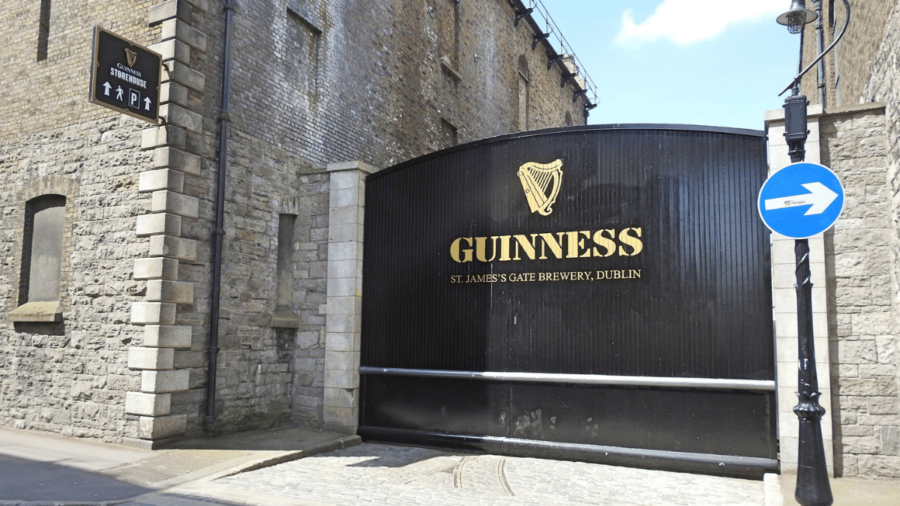
It‘s hard to believe that only a decade ago a Mintel consumer report gave the following damning verdict: “Simply put, Guinness is no longer cool.”
Sales of the stout were slumping as the spotlight fell on a new wave of craft beers and easy-drinking lagers. Fast-forward to today and the black stuff has made a roaring comeback. Guinness is the UK’s bestselling draft beer today, accounting for one in every nine pints pulled in pubs. Sales increased by 19% across Europe last year, while a YouGov survey recently crowned it the nation’s most recognised and popular beer brand.
“I never believed I’d see this day. It’s fantastic,” said Sir Ivan Menezes, CEO of parent company Diageo, on announcing bumper annual results last month. So, more than 250 years after its first pints went on sale, how did Guinness pull off such an impressive resurgence?
Taking the brand back to basics
For a time, Guinness got caught up in following fads, according to Pete Brown, journalist and author of Beer By Design: the art of good beer branding.
“Ray-Ban, Levi’s, Coca-Cola – they’ve all lost their way at some point chasing someone else’s market,” he says. “Guinness also had a time when it didn’t know what it was. It was launching all kinds of beers and line extensions.”
Brown believes that two things refocused the brand: the success of the Storehouse brewery experience in Dublin and the 2012 launch of its long-running ‘Made of more’ advertising campaign.
“A great thought like that acts as an attraction for customers, but it also reminds people working for the brand what they’re there for,” he says.

That gave the brand confidence to return to the “genuine core” of Guinness, says David Jenkinson, partner at branding agency Pearlfisher. “Most brands would kill for the [visual] assets that Guinness has. They don’t come more distinctive than the harp logo and the black and white. The recognition is unparalleled.”
While leaving those elements intact, Guinness subtly refined its branding to reinforce the heritage message, redrawing the harp by hand for a more rugged feel and introducing “Estd 1759” along with the signature of the founder of the business, Arthur Guinness.
Big-budget ad campaigns positioned the drink as ruggedly masculine but with a softer side, drawing on the brand’s core values of “power”, “goodness” and “communion”. Think 2013’s award-winning wheelchair basketball commercial highlighting male friendship or the film focusing on the support that Welsh rugby international Gareth Thomas received from his team when he came out as gay.
When we buy a beer, we’re buying a little bit of an attitude
Guinness has also doubled down on its association with Ireland by promoting St Patrick’s Day and invented holiday Arthur’s Day, which celebrates its founder.
“When we buy a beer, we’re buying a little bit of an attitude,” Brown argues. “The Irish internationally have this reputation for having the craic – a really good time. Going to an Irish pub or drinking Guinness gives other cultures permission to behave similarly.”
This kind of long-term brand-building doesn’t come cheap, of course. Between 2017 and 2022, Diageo upped its marketing expenditure for all drinks by £1bn globally – a 51% increase. It’s thought to spend about £100m promoting Guinness alone each year.
Keeping ahead of consumer shifts
Building those solid foundations has enabled Guinness to respond adroitly to broader changes in Britons’ drinking habits.
For instance, the two-part pour – which requires bar staff to pause halfway through pulling the pint to let it settle – has long been a unique selling point for the brand. But this ritual complicates matters in an era when consumers increasingly want to drink at home. In response, Guinness is marketing both a home draught tap and the Nitrosurge device. The latter attaches to special cans of the brew and, via a nine-part process, promises to pour pub-quality pints.
What of the upstart craft beer market? While Guinness tried to get in on the trend directly at first by launching limited-edition brews, the brand arguably now caters to those turned off by overpriced IPAs.
“Consumers are opting for a no-frills alternative at a more affordable price during a time of high inflation,” says Jane Gleeson, editor of Irish food magazine Guzzle.
At the same time, the new taste for more complex beers has boosted its popularity, according to Gill Sherwin, co-founder of online retailer Best of British Beer.
“People are drinking less during the week and saving it for the weekend,“ she says. “Then they want to drink something they perceive as a premium product. Lager drinkers tend to find it easier to move to Guinness than a craft ale, say, because of its flavour, coldness and creaminess.”
Although many pubs will offer a dizzying array of ales, Guinness is often the only stout they have on tap. That’s thanks to Diageo’s heft in distribution and close attention to quality control.
Sherwin says that when friends of hers who are “really into beer walk into a pub where the choice isn’t brilliant, they’ll go for a Guinness because they know what it’s going to be like”.
Amid the surge in popularity of alcohol-free beverages, Guinness got in on the action with its 0.0 beer. Launched in 2021, it has been front and centre of the brand’s marketing pushes around St Patrick’s Day and rugby union’s Six Nations Championship, with campaigns urging punters to drink responsibly.
Capturing the attention of younger drinkers
The great Guinness revival would have not been possible if the brand hadn’t been able to reach a wider base of consumers. Part of its slump can be attributed to the perception of stout as a heavy, old-fashioned drink – a world away from crisp, sparkling Mediterranean lagers.
“Guinness has been trying really hard to get to the younger audience since about 2018-19, doing everything it can on every single front,” says Beatriz Repiso, founder and CEO of Otternative Marketing.
Chief among those fronts is, of course, social media. Guinness has splashed out on dedicated content for Facebook, Instagram and YouTube that translates the cinematic feel of its television ads for each platform, such as 2017’s award-winning “Compton cowboys” series.
Social listening also comes into play, enabling Guinness to “analyse trends and how to jump on to these without losing the interest of their loyal customer base”, Repiso argues. “It looks for what the younger audience is attracted to and positions itself in front of those people, but without touching the brand values that are so important for the loyal customer.”
Take user-generated content, for instance. During the Covid lockdowns in the UK, Guinness spotted a trend for drinkers to post photos of everyday objects that reminded them of a pint of Guinness. It spun this into the #LooksLikeGuinness campaign to build anticipation for the reopening of pubs.
Pubs, we’ve missed you. See you inside. #LooksLikeGuinness pic.twitter.com/8jBeHrAkyZ
— Guinness GB (@GuinnessGB) May 13, 2021
At about the same time dozens of dedicated Guinness influencers started to pop up, sharing reviews, tips and memes. The #GuinnessChallenge, which challenges drinkers to sip their pint so that the remainder lines up with the bottom of branded glasses’ harp logo, has attracted 6.7 million views on TikTok. It’s the kind of organic engagement that most brands can only dream of.
Guinness has even encouraged what might seem, at first glance, less complimentary attention. For instance, it has collaborated with the creator of Shit London Guinness, an Instagram account which highlights badly poured pints in pubs across the capital, on product launches.
What’s next for Guinness?
Can the good times keep flowing? Diageo certainly thinks so. It’s set to open a £73m Guinness ‘culture hub’ at Old Brewers’ Yard in central London that promises a “grain-to-glass immersive visitor experience” in the mould of the Dublin original.
But it will need to capture more than just young people or occasional drinkers to keep growing in the UK, Jenkinson argues. Its success has led to other companies wanting in on the sector, with BrewDog launching its own stout, called Black Heart, at the start of the year. It has been trying to tap into Guinness’s core audience with taste testing at Six Nations games.
That means Guinness cannot rest on its laurels.
“I’d like to see Guinness be braver. It’s a question of how, with such a strong, bold, masculine heritage and brand expression, it adapts that to become relevant and appealing to a wider audience,” he says. “It’s both a challenge and a huge opportunity.”

It‘s hard to believe that only a decade ago a Mintel consumer report gave the following damning verdict: “Simply put, Guinness is no longer cool.”
Sales of the stout were slumping as the spotlight fell on a new wave of craft beers and easy-drinking lagers. Fast-forward to today and the black stuff has made a roaring comeback. Guinness is the UK’s bestselling draft beer today, accounting for one in every nine pints pulled in pubs. Sales increased by 19% across Europe last year, while a YouGov survey recently crowned it the nation’s most recognised and popular beer brand.
“I never believed I’d see this day. It’s fantastic,” said Sir Ivan Menezes, CEO of parent company Diageo, on announcing bumper annual results last month. So, more than 250 years after its first pints went on sale, how did Guinness pull off such an impressive resurgence?





